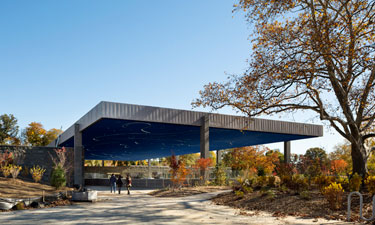 Dubbing the recent, massive overhaul of a portion of Brooklyn’s Prospect Park a “renovation” is perhaps an understatement. “It was a 300-space parking lot,” says Christian Zimmerman, vice president of capital and landscape management for Prospect Park Alliance (PPA). “There was no green space at all. [The lot] serviced that side of the park for picnicking, summer programs and the skating rink in the winter.”
Dubbing the recent, massive overhaul of a portion of Brooklyn’s Prospect Park a “renovation” is perhaps an understatement. “It was a 300-space parking lot,” says Christian Zimmerman, vice president of capital and landscape management for Prospect Park Alliance (PPA). “There was no green space at all. [The lot] serviced that side of the park for picnicking, summer programs and the skating rink in the winter.”
PPA, working with the New York City Department of Parks and Recreation, decided the spot was long overdue for an upgrade, and in February 2011, contractors broke ground on what is now known as Lakeside at Prospect Park. The $74 million project has completely transformed the 26-acre parcel, which is now suitable for year-round recreational use.
Going Old-School
While Lakeside at Prospect Park certainly breathed new life into the area previously known as Wollman Rink, the project could be viewed as a bit of a throwback to simpler times. “Originally this area was a carriage concourse designed by [Frederick Law] Olmsted and [Calvert] Vaux as a place to gather near the Concert Grove for events,” Zimmerman explains. The grove and its accompanying Music Island and Esplanade were central features of the late 19th-century park, which its designers envisioned as a space for Brooklyn residents to come together, whether for musical concerts or ice skating on the lake. Nearby were the Concert Grove House and Concert Grove Pavilion, which served as a restaurant/comfort station and tea house, respectively.
Around 1960, the area was completely overhauled with the construction of Wollman Rink, which offered ice skating in the winter and ample parking, but not much else. “[The parking lot had] destroyed [Prospect Park’s] most formal Olmsted and Vaux feature element,” Zimmerman says. “When we were making decisions [about the renovations], the question was, if we were going to build a new [skating] rink, do we build it in the same place or look for a new location? The consensus was, let’s build it in the parking lot, which will allow us to restore the Olmsted/Vaux landscape design.”
Indeed, contractors were able to reclaim about five acres of lake that had previously been filled in to accommodate the parking lot. Music Island was rebuilt within that re-excavated area, the granite walls along parts of the esplanade have been reconstructed, and fresh plantings of native trees, shrubs and other plants have been installed.
The building to which Zimmerman refers is perhaps the most ambitious part of the Lakeside project. The L-shaped structure is built from rough-hewn green granite and set into the topography of the park. The casual observer might regard the structure simply as old stone walls set slightly into the hillside, and the use of green roofing — plantings of sedums, grasses, shrubs and small trees — only adds to this illusion. The building’s east and north block are connected by a bridge, and visitors may walk on many parts of the structure’s roof. “It’s a big facility, but it’s embedded within the landscape so it appears deceivingly small,” Zimmerman says. “When you walk around you think, ‘Oh my gosh, it’s really big,’ even though you don’t see that much of the building, which is very Olmstedian.”
Year-Round Party
There was no doubt the dilapidated Wollman Rink would require a major overhaul, and Zimmerman and his team briefly considered dismantling the structure entirely in favor of a “pop-up” rink that could be set up seasonally. “We felt we needed to do more,” Zimmerman says.
To that end, architects designed two new rinks — a covered, regulation-size hockey rink that can be used for ice skating in the winter and roller skating in the summer, and an open, exterior elliptical recreation rink that converts to a water feature in the warmer months. This clever addition not only made accommodations for year-round recreation, it also restored yet another beloved feature of the surrounding neighborhood that had been lost to the past. “There used to be a roller-skating rink called Empire Skating, but it had closed down in the neighborhood,” Zimmerman explains. “We held these community input meetings in the early planning stages — all these little children came in with tears in their eyes and asked us to rebuild their skating rink. As we were [thinking about] summer uses [for the park], a roller-skating rink became a no-brainer.”
Add to those features the reclaimed and newly established green space — about eight acres in total — and you’ve got a park that easily accommodates a variety of year-round recreational uses. “The community response has been resoundingly positive,” Zimmerman says. “What’s wonderful is to see how the use changes throughout the day....[Lakeside is now a] true multiuse site.”
Samantha Bartram is the Associate Editor of Parks & Recreation Magazine.

